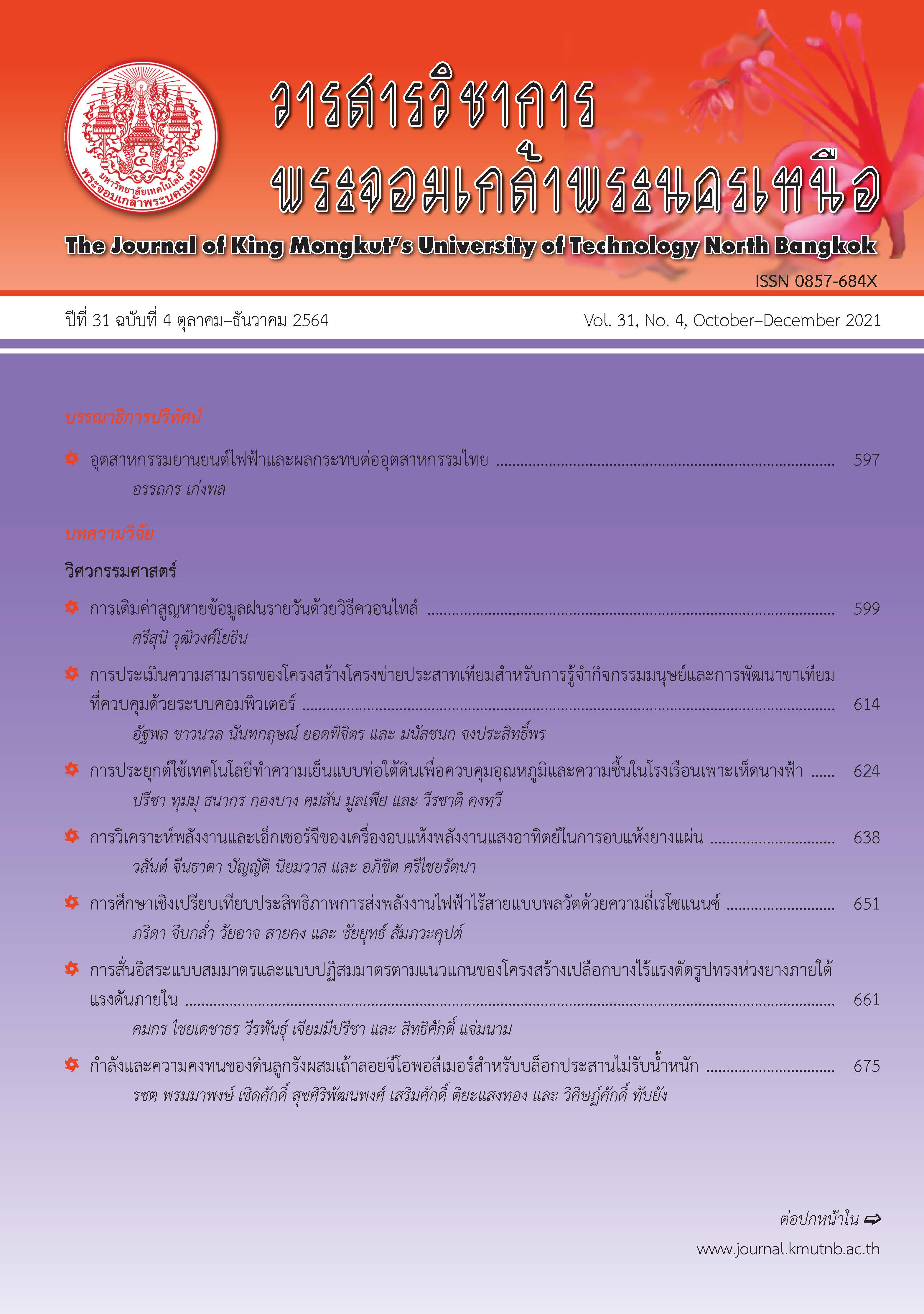การประยุกต์ใช้เทคโนโลยีทำความเย็นแบบท่อใต้ดินเพื่อควบคุมอุณหภูมิและความชื้นในโรงเรือนเพาะเห็ดนางฟ้า
Main Article Content
บทคัดย่อ
งานวิจัยนี้มีวัตถุประสงค์เพื่อศึกษาการประยุกต์ใช้งานระบบทำความเย็นแบบท่อใต้ดินร่วมกับระบบพ่นหมอกและระบบควบคุมอัตโนมัติ เพื่อช่วยควบคุมอุณหภูมิและความชื้นภายในโรงเรือนเพาะเห็ดนางฟ้า วิธีการในการศึกษาเริ่มจากการศึกษาอุณหภูมิใต้ดินที่ระดับความลึก 3 ระดับ ของกลุ่มดิน 3 ประเภท ในเขตจังหวัดอุดรธานี ต่อมาจะทำการคำนวณออกแบบระบบความเย็นแบบท่อใต้ดิน และสร้างระบบจริงพร้อมกับโรงเรือนเพาะเห็ดขนาด 2.25 ม. X 2.25 ม. สูง 2.4 ม. จากนั้นจะทำการศึกษาสมรรถนะการทำงานของระบบ พร้อมทั้งมีการทดลองนำเห็ดนางฟ้ามาเพาะเลี้ยงจริงในระบบเปรียบเทียบกับโรงเรือนเพาะเห็ดแบบดั้งเดิม ผลการศึกษาพบว่า อุณหภูมิใต้ดินในเขตจังหวัดอุดรธานีมีค่าเฉลี่ยอยู่ที่ประมาณ 27-30 องศาเซลเซียส ซึ่งมีศักยภาพในการใช้ระบบทำความเย็นแบบท่อใต้ดิน โดยความลึกที่เหมาะสมในการวางระบบอยู่ที่ 1.5-2 ม. เนื่องจากมีอุณหภูมิคงที่ และไม่ได้รับอิทธิพลภายนอกอื่นๆ เมื่อทดลองติดตั้งระบบทำความเย็นใต้ดินที่ความลึกดังกล่าวพบว่า ระบบสามารถช่วยลดอุณหภูมิอากาศให้ต่ำกว่าอากาศภายนอกประมาณ 5 องศาเซลเซียส ในช่วงกลางวันที่อากาศร้อนจัด โดยหากเพิ่มความเร็วลมในท่อจะมีผลเล็กน้อยในการช่วยอุ่นอากาศในช่วงที่อุณหภูมิอากาศต่ำกว่าอุณหภูมิใต้ดิน และเมื่อนำระบบดังกล่าวไปใช้ร่วมกับโรงเรือนเพาะเห็ดที่สร้างขึ้นมาผลที่ได้พบว่า ที่ความเร็วลม 5.4 เมตรต่อวินาที จะสามารถช่วยลดอุณหภูมิภายในโรงเรือนให้ต่ำกว่าอากาศภายนอกได้ประมาณ 4 องศาเซลเซียส และสูงกว่าอุณหภูมิใต้ดินเพียง 0.5 องศาเซลเซียส เนื่องจากที่ความเร็วลมดังกล่าวจะมีอัตราการถ่ายเทความร้อนของอากาศในโรงเรือนสูงที่สุด และเมื่อมีการติดตั้งระบบพ่นหมอกพร้อมระบบควบคุมอัตโนมัติในโรงเรือนเพิ่มเติม จะสามารถช่วยรักษาความชื้นสัมพัทธ์อากาศในโรงเรือนให้สูงกว่า 80 เปอร์เซ็นต์ ได้ตลอดเวลา ซึ่งเหมาะต่อการเพาะเห็ดนางฟ้าอย่างมาก ซึ่งเมื่อทำการทดลองนำเห็ดนางฟ้าจำนวน 400 ก้อน มาเพาะจริงเป็นเวลา 1 เดือนในระบบเทียบกับการเพาะในโรงเรือนเพาะเห็ดแบบดั้งเดิมพบว่า ปริมาณดอกเห็ดที่ได้มีจำนวนกว่าโรงเรือนเพาะเห็ดแบบดั้งเดิมถึง 23 เปอร์เซ็นต์ และลดเหลือ 12 เปอร์เซ็นต์ เมื่อพิจารณาต้นทุนในการสร้างโรงเรือนเพาะเห็ดร่วมกับเทคโนโลยีทำความเย็นแบบท่อใต้ดินที่เพิ่มขึ้นจากโรงเรือนดั้งเดิม นอกเหนือไปจากนี้ยังพบว่า ระบบที่พัฒนาขึ้นมานี้มีศักยภาพสูงที่จะช่วยให้เกษตรกรสามารถเพาะเห็ดนอกฤดูกาลในช่วงที่อากาศร้อนได้อีกด้วย
Article Details
บทความที่ลงตีพิมพ์เป็นข้อคิดเห็นของผู้เขียนเท่านั้น
ผู้เขียนจะต้องเป็นผู้รับผิดชอบต่อผลทางกฎหมายใดๆ ที่อาจเกิดขึ้นจากบทความนั้น
เอกสารอ้างอิง
[2] Department of Agricultural Extension. (2017). List of community enterprises. [Online]. Available: https://smce.doae.go.th/ProductCategory/SmceCategory.php
[3] Kung Krabaen Bay Royal Development Study Centre. (2020). Economic Mushroom Production. [Online]. Available: https://www4.fisheries.go.th/
[4] Q. A. Mandeel, A. A. Al-Laith, and S. A. Mohamed, “Cultivation of oyster mushrooms (Pleurotus spp.) on various lignocellulosic wastes,” World Journal of Microbiology and Biotechnology, vol. 21, pp. 601–607, 2005.
[5] P. Patel and R. Trivedi, “Importance and effect of substrate for the cultivation of pleurotus sajor-caju,” International Journal of Science and Research (IJSR), vol. 4, no. 1, pp. 1324–1326, 2015.
[6] G. M. Philip and C. Shu-Ting, Mushrooms: Cultivation, Nutritional Value, Medicinal Effect, and Environmental Impact, 2nd ed., CRC Press, 2004.
[7] C. P. Pokhrel, N. Kalyan, U. Budathoki, and R. K. Yadav, “Cultivation of Pleurotus sajor-caju using different agricultural residues,” International Journal of Agricultural Policy and Research, vol. 1, no. 2, pp. 019-023, 2013.
[8] S. A. Shinde, A. B. Pandey, and S. S. Patil, “Temperature and light intensity influences on growth of Pleurotus sajor-caju,” Journal of Chemical, Biological and Physical Sciences, vol. 6, pp. 261–265, 2016.
[9] M. Rout, K. Mohapatra, and P. Mohanty, “Studies on effect of incubation temperature and light intensity on mycelial growth of oyster species,” Journal Crop and Weed, vol. 11, pp. 44–46, 2015.
[10] S. Thepa, K. Kirtikara, J. Hirunlabh, and J. Khedari, “Improving indoor conditions of a Thai-style mushroom house by means of an evaporative cooler and continuous ventilation,” Renewable Energy, vol. 17, no. 3, pp. 359–369, 1999.
[11] I. M. A. Aljubury and H. D. a. Ridha, “Enhancement of evaporative cooling system in a greenhouse using geothermal energy,” Renewable Energy, vol. 111, pp. 321–331, 2017.
[12] M. Ghoulem, K. El Moueddeb, E. Nehdi, R. Boukhanouf, and J. Kaiser Calautit, “Greenhouse design and cooling technologies for sustainable food cultivation in hot climates: Review of current practice and future status,” Biosystems Engineering, vol. 183, pp. 121–150, 2019.
[13] N. Nkolisa, L. S. Magwaza, T. S. Workneh, and A. Chimphango, “Evaluating evaporative cooling system as an energy- free and cost- effective method for postharvest storage of tomatoes (Solanum lycopersicum L.) for smallholder farmers,” Scientia Horticulturae, vol. 241, pp. 131–143, 2018.
[14] Y. Uchida, K. Yasukawa, N. Tenma, Y. Taguchi, T. Ishii, and J. Suwanlert, “Subsurface temperature survey in Thailand for geothermal heat pump application,” Journal of the Geothermal Society of Japan, vol. 33, pp. 93–98, 2011.
[15] S. Mongkon and S. Polvongsri, “Enhancement of the cooling performance of earth tube system by increasing soil moisture for use in agricultural greenhouse,” RMUTI Jounal of Science and Technology, vol. 9, no. 3, pp. 151–164, 2016 (in Thai).
[16] S. Bantoengpaiboon, “Energy saving air conditioning system design with a ground heat exchanger,” M.S. thesis, School of Construction and Infrastructure Management, Suranaree University of Technology, 2018 (in Thai).
[17] T. Sri-on and A. Koonsrisuk, “Cooling performance of a hybrid ground-source heat pump with different cooling-water loop configurations,” in Proceedings The 34th National Graduate Research Conference, 2015, pp. 188–197 (in Thai).
[18] M. C. Lekhal, R. Belarbi, A. M. Mokhtari, M.-H. Benzaama, and R. Bennacer, “Thermal performance of a residential house equipped with a combined system: A direct solar floor and an earth–air heat exchanger,” Sustainable Cities and Society, vol. 40, pp. 534–545, 2018.
[19] Land Development Department. (2016). Provincial soil resource information. [Online]. Available: http://www.ldd.go.th/www/lek_web/
[20] Y. A. Cengel and A. J. Ghajar, Heat and Mass Transfer: Fundamentals and Applications. McGraw Hill Education, 2015.
[21] A. A. Serageldin, A. K. Abdelrahman, and S. Ookawara, “Earth-air heat exchanger thermal performance in Egyptian conditions: Experimental results, mathematical model, and Computational Fluid Dynamics simulation,” Energy Conversion and Management, vol. 122, pp. 25–38, 2016.
[22] P. Patel and R. Trivedi, “Effect of substrate and spawn rate on the growth parameter, yield and biological efficiency of pleurotus sajor-caju,” International Research Journal of Natural and Applied Sciences, vol. 1, no. 6, pp. 82–92, 2014.

